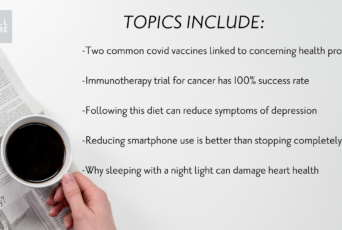Dr. Maya Shetreat was first inspired to go into the field of psychoneuroimmunology (the study of how the mind affects our health and resistance to disease) by a documentary — but it wasn’t until she had a firsthand health scare with her own son that she made it her mission to educate people about the gut-brain connection. Today, the pediatric neurologist i.e. brain doctor for kids, and author of the book The Dirt Cure helps treat children by looking at food and the microbiome, rather than writing a prescription.
*This is a short clip from Dr. Shetreat’s full interview— click here to watch the whole thing.*
You can also listen to our interview with Dr. Maya Shetreat on The WellBe Podcast.
Experiencing the Gut-Brain Connection Firsthand
When she was in college, Shetreat watched a Bill Moyers’ special called Healing and the Mind, and it set the course for her career. “I thought, ‘Wow, I want to work with mind, body and think of the body as physical, emotional, and spiritual,’” she remembers. She explains that this is what drew her to the field of psychoneuroimmunology, the study of how the mind affects our resistance to disease. She went on to medical school, where she was trained in pediatrics and neurology, and during that time got married and had three children. Her life had become very busy and focused, and she’d drifted somewhat from her more integrative interests.
Then, when Dr. Shetreat was close to finishing med school, her youngest child developed severe breathing issues at the same time that he reached a developmental plateau; he was falling all the time, and completely stopped gaining new vocabulary. Perhaps worst of all, nobody had any idea what to do or why it was happening. “All the great doctors and colleagues I took him to had nothing to say,” Dr. Shetreat remembers.
Ultimately, Dr. Shetreat figured out that he was severely allergic to soy. When she took him off soy, his breathing issues — and all other problems — completely reversed. At that point, she realized not only how powerful food could be, but also the strength of the gut-brain connection, mediated through the immune system. “I wanted to be able to bring that to not just my family, but to my patients and the larger community as well,” says Dr. Shetreat.
She explains that when a typical pediatric neurologist sees a patient, they will take a very detailed history and do a very detailed exam, and then, more often than not, the child will be given a pharmaceutical as their treatment. “In my practice,” she says, “I did not want to write a prescription for every kid who walked through my door. I felt like there had to be another way.”
The Link Between Neurological Issues Like ADHD and Food
Dr. Shetreat dove into the literature, seeking to better understand the gut-brain connection. She immersed herself in research around nutrition and herbs as a path to healing neurological conditions, and found an approach that works — and that remains the mainstay of her practice. Patients come to her with a wide range of issues, from OCD to ADHD to autism to seizure disorders to conditions that nobody can figure out, and in the vast majority of cases, she is able to heal their symptoms without writing a prescription. “So often,” she says, “the root cause is related to what the kids are eating.”
The link between issues like OCD or ADHD and food isn’t a straight line, and because each person has a unique microbiome, the correct nutritional guidance will be different from child to child. However, Dr. Shetreat’s understanding of the gut-brain connection has helped her develop a set of standard recommendations that can be applied to nearly every patient she sees.
“The first thing that I tell parents, across the board, whether a child has an issue or if they’re perfectly fine and you don’t want them to develop any issues, is to really cut processed food as much as possible,” says Shetreat. She explains that this is because processed foods contain food chemicals like MSG, aspartame, food dyes, and others, all of which can be disruptive to neurological health. “ I’ve seen very miraculous reversals at times simply by just cutting out food chemicals,” Shetreat says.
The next thing Dr. Shetreat recommends is looking for food reactivity or sensitivities. “A child who has, let’s say, eczema or hives or rashes or stomach aches, oftentimes they’re reacting to a food,” she says. “When you remove that food, then you see a huge leap in neurologic health, mood, behavior, all of those things.”
The third recommendation Dr. Shetreat makes is to eat more healthy fats. She explains that the brain is composed of 60% fat, and so it’s important that learning, growing children incorporate lots of healthy fats and healthy cholesterol into their diet (more than 20% of your body’s cholesterol is in the brain, where it helps neurotransmitters communicate with one another). Organic pasture-raised butter, ghee, coconut oil, and olive oil are all examples of healthy fats that Dr. Shetreat says are “critically important for brain health and for mood health.
Why Children Need “Good Germs” In Order to Stay Healthy
A close relationship with the natural environment is another central component of Dr. Shetreat’s approach. When working with patients, she encourages parents to get their kids outside in nature, where they can be exposed to the diverse realm of microorganisms that help keep our microbiomes — and, in turn, our immune systems and brains — functioning properly. Her book, The Dirt Cure, drives this point home, explaining how important these so-called good germs are to our health. In the book, she explains that children need to be exposed to dirt in three ways:
1. Being exposed to germs and microbes
2. Eating fresh food from healthy soil
3. Getting out into nature
By paying attention to these three areas, she’s found a new way to heal neurological conditions that up until now have been treated only with pharmaceuticals.
Dr. Shetreat explains that for a long time, the conventional wisdom was that being hygienic and sterile was the best way to be healthy, but that this misunderstands the way our bodies work. Our microbiome contains three to five pounds of bacteria, and all of these organisms are working with our body to keep us healthy — so when you reduce or eliminate exposure to a diverse array of organisms, you’re crippling your immune system.
“Meanwhile, kids are washing their hands with antibacterial soap. They’re on antibiotics at the drop of a hat. Houses are being cleaned with bleach. Kids are indoors so much,” she says. “Whatever it is, they’re not getting that diverse exposure to the microorganisms that are really very critical for gut, immune, and brain health.”
As an illustration of that, she points to studies that compare the gut health of children who live on farms to that of those who live in urban apartments. The findings show that the children in rural environments have far more diverse exposure to bacteria, and are subsequently less likely to develop allergies, asthma, autoimmune conditions, and other health problems. This broad array of different microorganisms also makes them better prepared to fight infection because no one organism will grow out of control, Dr. Shetreat explains.
How much exposure to dirt and the natural environment do you get in your daily life? Tell us in the comments below!
Watch our full interview with Dr. Shetreat to learn how she handles the pushback she’s received from colleagues, about the emerging field of psychobiotics (the impact of microbes on our mood and cognition), what “terrain medicine” is and why it’s so important, why touching a subway pole won’t give you the good kind of bacteria you want, the role that gardening and raising animals plays in her practice, exactly how clean your fruits and vegetables should ideally be, and why “all healing really comes from the earth.”
The information contained in this article comes from our interview with Dr. Maya Shetreat, MD. Her qualifications and training include graduating from the Albert Einstein College of Medicine, where she specialized in pediatric neurology. She is also an herbalist, urban farmer, and author. Additionally, she is the founder of the Terrain Institute, where she teaches online programs in transformational earth-based healing. You can learn more about her here.
Citations:
- Niaz, Kamal et al. “Extensive use of monosodium glutamate: A threat to public health?.” EXCLI journal vol. 17 273-278. 19 Mar. 2018.
- Choudhary AK, Lee YY. Neurophysiological symptoms and aspartame: What is the connection? Nutr Neurosci. 2018 Jun;21(5):306-316.
- Weiss, Bernard. “Synthetic food colors and neurobehavioral hazards: the view from environmental health research.” Environmental health perspectives vol. 120,1 (2012): 1-5.
- Jin, Uram et al. “Cholesterol Metabolism in the Brain and Its Association with Parkinson’s Disease.” Experimental neurobiology vol. 28,5 (2019): 554-567.
- Matthias Orth, Stefano Bellosta, “Cholesterol: Its Regulation and Role in Central Nervous System Disorders”, Cholesterol, vol. 2012, Article ID 292598, 19 pages, 2012.








Hi there very cool web site!! Guy .. Beautiful ..
Wonderful .. I will bookmark your blog and take the feeds additionally?
I’m happy to find a lot of helpful information here in the submit, we
want work out extra techniques in this regard, thank you for sharing.
. . . . .
Dr. Maya Shetreat is really great. I get many things from this video.
thank you for sharing with us.
You’re so welcome – she is great!